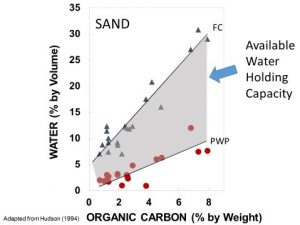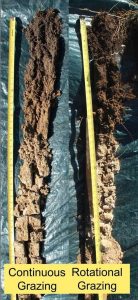The Soil Health Institute and the Water-Soil Health Connection
The Soil Health Institute (SHI) was created in 2015 to “Safeguard and enhance the vitality and productivity of soil through scientific research and advancement.” As the independent, non-profit organization charged with coordinating and supporting soil stewardship and advancing soil health, the SHI is focused on fundamental, translational, and applied research and ensuring its adoption. Enhancing soil health allows us to improve water quality, increase drought resilience, reduce greenhouse gas emissions, improve farm economies, provide pollinator habitat, and better positions us to feed the nine billion people expected by 2050.
The SHI works with a broad base of stakeholders to:
- Identify gaps in research and adoption;
- Build research/implementation strategies and their corresponding networks necessary to appropriately address those gaps;
- Seek and obtain funding to address the above gaps;
- Administer an accountable, transparent, and technically proficient competitive grants program;
- Ensure impact of the investments;
- Incorporate research results into educational materials; and
- Enhance partnerships for increasing technology transfer and adoption.
Numerous stakeholders provided input to our Action Plan, entitled “Enriching Soil, Enhancing Life: An Action Plan for Soil Health”. This identifies gaps in key areas of research, measurements, economics, communication/education, and policy; and specifies actionable steps to address those gaps.
Soil Health Benefits

Figure 1. Relationship between soil organic carbon and available water holding capacity in soils of sand particle size. FC = Field Capacity, PWP = Permanent Wilting Point. (adapted from Hudson, 1994).
One great benefit to improving soil health resides in the relationship between soil organic carbon and a soil’s capacity to hold plant-available water, e.g., Fig. 1, where increasing soil organic carbon is clearly shown to increase available water holding capacity.
A review of several studies conducted across a range of soil textures reported that a 1 gram increase in soil organic carbon increased available water by 1 to 4.9 grams for every 100 grams of soil. Therefore, increasing soil organic carbon can significantly enhance resilience of our soils, cropping systems, and grazing systems to both drought and heavy precipitation.
Opportunities for increasing soil organic carbon can occur in rangeland as well as cropland. As demonstrated over a 21-year study, light (prescribed) grazing increased soil organic carbon even above that level maintained with no grazing at all (Table 1). Such an effect can be seen readily in the field (Fig. 2).
| Treatment | Soil Organic Carbon, 0-5 cm (Mg/ha)* |
Soil Nitrogen, 0-5 cm (Mg/ha) |
|---|---|---|
| No Grazing | 10.8 b | 0.94 b |
| Light Grazing | 13.8 a | 1.23 a |
| Heavy Grazing | 10.9 b | 0.94 b |
| *Numbers within a column followed by the same lower case letter are not significantly different at the 0.05 level. | ||
Cover Crops and Crop Rotations

Figure 2. Soil cores from land under different grazing practices; the darker color reflects carbon accumulation, and is both darker and deeper under rotational grazing than continuous grazing. (Photo: USDA-NRCS)
Soil health-promoting practices such as cover crops are a valuable tool for enhancing soil health and reducing nutrient losses through surface runoff and leaching. As demonstrated across a wide range of soils and climates, cover crops can reduce nitrate leaching losses by over 60% (Table 2 below). Indeed, a meta-analysis of 69 separate studies from across the U.S. showed that cover crops reduced nitrate leaching losses by an average of 70%.
Other practices such as crop rotation and nutrient management also play key roles for protecting and enhancing water quality through soil health. In fact, reduction in nitrate loss to groundwater is generally due to plant uptake of that nitrate by the cover crop.
Consequently, to ensure benefits to water quality, fertilizer recommendations for the following crop must account for nitrogen that will become available from the decomposing cover crop, or perhaps any manure applications. As many practices used to enhance soil health influence nutrient availability, nutrient management is inherently a key soil health practice, and an entire systems perspective is required to optimize benefits and minimize nutrient losses.
| Location | Cover Crop | Reduction in Nitrate Leaching (%) |
|---|---|---|
| California | Rye | 65-70 |
| Delaware | Rye | 30 |
| France | Ryegrass | 63 |
| Indiana | Winter Wheat (and reduced fertilizer) |
61 |
| Iowa | Rye | 61 |
| Kentucky | Rye | 94 |
| Kentucky | Hairy Vetch | 48 |
| Maryland | Rye | 77 |
| Maryland | Rye | 80 |
| Michigan | Rye | 28-68 |
| Minnesota | Rye | 13 |
The efforts of the Soil Health Institute and its partners
The efforts of the Soil Health Institute and its partners are designed to move knowledge and technology from the research laboratory to the farm field by bringing together traditional and non-traditional agricultural industry partners, farmers, ranchers, government agencies, scientists, and consumers to focus on one common, clear goal: protecting and enriching our soils, our environment, and indeed, our lives. All who wish to participate in this journey are invited to join and help make soil health the cornerstone for managing our natural resources around the world.
Authors: Steven R. Shafer and C. Wayne Honeycutt, Soil Health Institute
Reviewer: Rob Myers, North Central Region SARE
Funding support from North Central Region Water Network.